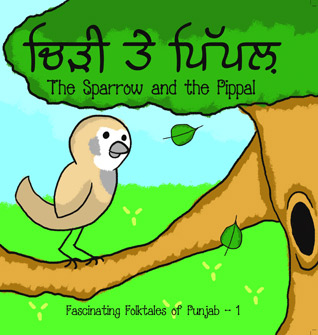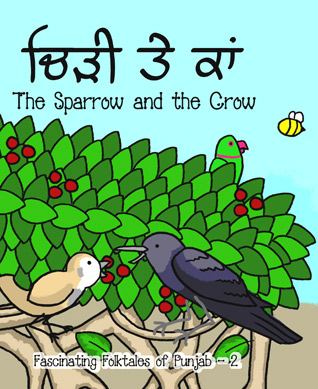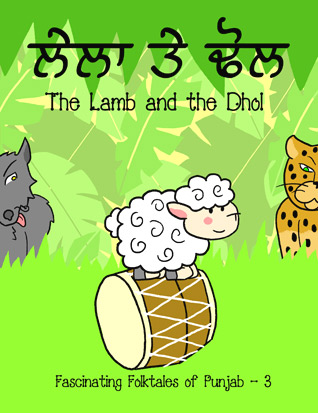Kids' Corner
The Sparrow, The Lamb, and The Crow
T. SHER SINGH
A NEW SET OF CHILDREN'S BOOKS ... WITH PUNJABI NURSERY RHYMES
Ik si chirri tey ik si kaa(n)
Dovei(n) rehndey boharrh di chhaa(n)
Chirri si bholi, kaa(n) syaana
Chirri nu labha kanak da daana ...
There was once a sparrow ... and a crow
Both lived in the shade of the Boharrh tree's boughs
The crow was crafty, the sparrow was sweet
The sparrow found a kernel of wheat.
We do it like the birds.
We carefully, lovingly, patiently, nurture our young, step by baby step, starting from their helpless beginnings all the way to when they are all grown-up and ready to tackle the world on their own.
It begins with a cacophony. Then, ever so slowly, a pattern emerges from within the din of primal sounds, followed by a semblance of language. We guide it, first through monosyllabic utterances, then emerging word formations, and thereon into song.
Subsequently, that song turns into meaning … and substance.
My first encounter, as an observer, of such a process was not a pleasant one.
My sister Sunder was a pest as a kid. Though only four years younger than me, the age difference seemed vast when we were children. She was cute and bright and had, early on, latched into the power of nursery rhymes.
She had lapped up every song then known to Man … in English, Punjabi, Hindi and nonsense … she could devour a verse faster than a glass of Glaxo milk or a swill of Woodward’s Gripe Water. All you had to do was make the mistake of asking her to sing when guests were visiting.
She loved the limelight. Initially, she would wow us with her prowess. But then … she wouldn’t stop. Hour after hour, it seemed, she’d carry on standing at the periphery, singing away, hand and body movements and all. Nothing could stop her.
The endless repertoire of nonsensical sounds: “Ba-Ba Black Sheep,” the “Twinkle-Twinkle,” the “Chandaa Maama” … was ultimately replaced with formal musical training in classical music and kirtan singing.
Having a bevy of sisters forever doing vocal exercises with the full use of their lungs was not designed to make a young boy’s life a pleasant experience.
It wasn’t until years later that I was able to appreciate and relish, and then revel, in their kirtan. In many ways, it provided a high standard early on for me in my life-long quest for inspiring and elevating kirtan.
Now that I look back, I realize … it all started with nursery rhymes.
Simple ditties. The fact that they had no great meaning or message made them easier to teach and learn. The fact they were free of religion and ritual made them attractive: because they weren’t a chore.
The heavier stuff would come later, as the brain matured and one was ready to tackle substance.
Thus nursery rhymes are integral to human growth. They create behavioural patterns, not just language ones. Like learning tables by rote at a time when they are mere “sound and fury signifying nothing.”
If we rush things too early, we sabotage the process and create anomalies. Therefore, taking things in proper sequence and timing is important.
It is therefore such a delight to see new and necessary tools being created in our community to address this principle.
So far, we have steadily developed good materials to introduce our children to Sikhi as well as Punjabi and Gurmukhi. But we have neglected the earlier, foundational step which is handled through nursery rhymes.
We tend to short-cut the process of going straight to teaching the Mool Mantar and “deh shiva bar mohe ihai …“ and bypass the earlier step of building a base of language patterns.
Nobody’s fault. We just haven’t had the tools needed in our redefined, reformulated communities in the diaspora.
Therefore, Gurmeet Kaur’s latest gift -- a three ’book’ set of children’s board-books -- is a blessing. As much for the child as for the parent.
It consists of three separate stories, each with 9 or 10 glossy panels in glorious colour, adorned with child-friendly illustrations … and a verse or two of a nursery rhyme. In Punjabi/Gurmukhi.
These have obviously been created with a child’s needs in mind.
The board construction of the pages makes them “child-proof” … they cannot injure and they cannot be injured.
It appeals to a child’s multiple senses: she is mesmerized by the illustrations, while the parent can simultaneously read from the page.
The ditties are addictive, as all nursery rhymes are: repetitive, rhyming, sing-song, sing-along, musical, alliterative, onomatopoetic, and in short syllables that easily roll off the tongue.
The figures on the page are, in Panchtantar and Aesop fashion, limited to birds and animals. Good. Not every children’s qaaida (primer) needs to be filled with karras and joorrahs … we need to learn to dole out messages to our children in the right dosages and proportions and not overwhelm them early on (or ever, for that matter) with religious imagery and messages.
I love the age-appropriateness of these books.
And I know they work.
I saw a two-year old loll and roll on the sofa, holding one of these books open in her lap, her eyes glued to the page even as her body writhed and fidgeted in acrobatic maneuvers. Her mother would read a word or two, here and there, and the child sang along, completing the verses on her own.
And then, she knew, on her own and without a cue, exactly when to flip the page … and continue.
With one book done, she threw it down, picked up another, and repeated the process. No encouragement or bribery or cajoling was necessary.
The child was having fun.
Which means, she was learning.
[Please watch the two videos linked below -- one in Punjabi, one in English -- to see how little children react to these books.]
For too long we have struggled with poor educational tools and we have spent too much time, each parent in each successive generation, inventing and re-inventing them for our own nests and then losing them once the nest is empty.
I Chirri tey Pippal - The Sparrow and the Pippal Tree
II Chirri tey Kaa(n) - The Sparrow and The Crow
III Laila tey Dhol - The Lamb and the Drum
Considering that we have, in the diaspora at the very least, done without such excellent teaching tools for generations, I am quite sure the parents will pick up new vocabulary as well. A tool that teaches toddlers and adults alike?
The verses are borrowed from the folktale riches of Punjab. Some will bring back memories, others will provide new experiences for all.
Though the text on each page is in Gurmukhi, the last two panels provide a transliteration for each verse, and an English translation. For those of us parents who aren’t fluent with Gurmukhi. Maybe it’ll encourage us to join Punjabi classes along with our toddlers.
Finally, there are Activity Books that accompany each of the three board books, wherein children can play with pencil and crayon and do what they do best.
Frankly, I love these lovely creations. They’re such a delight.
If I gush over them, it is because I wish they’d been around when I was a child; my Punjabi would be better now if they had.
I wish they’d been around when my daughter was a child. I know she would have enjoyed them.
But. Not a problem. There are kids galore in the firmament … nieces and nephews. Each of them … and their parents! … deserves a set.
Please CLICK here for Punjabi Video.
And CLICK here for English Video.
Please CLICK here to purchase books, or for more info.
March 5, 2013
Conversation about this article
1: Parvinder Singh (Atlanta, Georgia, U.S.A.), March 05, 2013, 8:39 AM.
Great initiative. It's wonderful to have these nursery rhymes recorded with pictures. Toddlers like them. It also provides them an opportunity to get closer to, and learn, Punjabi. Keep up the good work. Guru Sahib kirpa banayi rakhan.
2: Shelby Steinhauer (Atlanta, Georgia, USA), March 05, 2013, 10:09 AM.
I agree with everything T. Sher Singh said about nursery rhymes. I watch in delight as Gurmeet's daughter Liv recites rhyme after rhyme for me in English. I watch iPhone videos of her at home to make my heart sing when I can't be with her. How much more important then is it for her to have these resources in her mother tongue? Who will pass on Punjabi to the next generation if the youngest of children are not engaged in and in love with their own language? Gurmeet's work on these books from start to finish was truly a love letter to her children and to all Punjabis. The benefit to her daughter and all Punjabi-speaking children and caretakers is immeasurable. Bravo!
3: Jasmine Kaur (USA), March 05, 2013, 12:18 PM.
These books are definitely a great addition to the children's resources that have recently been introduced to the Sikh community in the last couple of years. This is particularly useful as it is in Gurmukhi and introduces the readers to Punjabi vocabulary. Congratulations, Gurmeet Kaur, to you and your team for putting out a much needed resource for our little ones!
4: Ish Amitoj Kaur (Fremont, California, USA), March 05, 2013, 1:34 PM.
This article has indeed added luster to this wonderful product. I had the honor of receiving a copy of one of these books for my baby shower. And as T. Sher mentioned, in addition to the shabads, my baby got immersed in the little jingles gifted to us by Gurmeet Kaur. My son is going to be four months but still opens his mouth in awe when I recite the story to him. Kudos to your efforts, Gurmeet. It does take a lot of sweat and blood to indulge in such efforts. I hope we are able to make the most of something that's tailor made for us, in our own language, for our generations to come.
5: Pinki (Cumming, Georgia, USA), March 05, 2013, 9:46 PM.
Excellent work. It's wonderful to have these nursery rhymes recorded with pictures. Kids will love them. It also provides them an opportunity to get closer to our virsa (heritage) and learn Punjabi. Keep motivating the kids to remember their mother tongue and attach with their virsa.
6: Sukhwinder Singh (Vismaad) (Ajitgarh, Punjab), March 06, 2013, 1:01 AM.
It's been over seven years since I first met Gurmeet Kaur at the Spinning Wheel Film Festival in 2005. Her love for Punjabi and Sikhi has only grown stronger all these years. She is one of those few who have realized the importance of keeping Punjabi alive in our homes and has ever insisted to keep Vismaad movies in Punjabi only. This love for Punjabi and importance of keeping the traditions alive have culminated into these wonderful books of which I have only seen online glimpses. Knowing that these books have come from a mother who wants her young daughter to be rooted with her heritage, I have no doubt that these books are world class. I missed the joy of holding a book in my hands by a few days only as the shipment landed in Los Angeles a few days after I headed back home from my recent US visit. Congratulations, Gurmeet Kaur ji. With mothers like you around, we know Punjabi is safe and the tradition will carry on to the next generation of Liv Kaurs.
7: Ravinder Kaur (Belgium), March 06, 2013, 8:03 AM.
I am so happy ... I have been looking for something like this for my seven-month old daughter. Thanks for the article!
8: Inni Kaur (Fairfield, Connecticut, USA), March 06, 2013, 11:23 AM.
Gurmeet, thank you for this incredible treasure! I did not grow up with Punjabi nursery rhymes. Therefore I did not know of their existence. However, when I read these rhymes to my husband I was shocked. He knew them and recited quite a few more. His mother had taught him these rhymes. We spent a wonderful evening reminiscing about his childhood. After 36 years of marriage, there are still things we are discovering about each other. While I am sure the children will love these books, there is another audience.
9: Manjit Singh Bara Pindia (Canada), March 06, 2013, 12:21 PM.
From the description of the books given and the video referred to in the article, they seem to be excellent work. To keep Punjabi language alive among the children growing up in the diaspora, such works are most definitely needed. For children learning Gurmukhi, alphabet with proper tonal sounds is also important. In that regard, I have noticed that even small children react very well to videos. For example, check out the "Sikh TV Punjabi Alphabet" video: http://www.youtube.com/watch?v=UQPGYUHO7DY
10: Amardeep (USA), March 06, 2013, 2:50 PM.
Heard great things about these books. Love to hold the books in my hands soon and read them to my daughter.
11: Harminder Singh (Jalandhar, Punjab), March 06, 2013, 11:46 PM.
Another good article and review by T Sher Singh. These books will be beneficial for all children.
12: Jasminder Kaur (Newark, New Jersey, USA), March 09, 2013, 2:21 PM.
Gurmeet Bhen ji, I have heard all praises of the work you do with United Sikhs. Keep up the great work, we support your work and hope that these books reach the households of all Sikhs.
13: Gurmeet Kaur (Atlanta, Georgia, USA), March 21, 2013, 9:49 PM.
Books are now available in Canada at: Gurfateh Sewa Center | 7875 Tranmere Dr., Mississauga, Ontario, Canada L5S 1T8 | 11 am to 6 pm. Closed Tuesdays | Email: gsc.canada@gmail.com | Phone: (905) 671-3131, (647) 801-6806.
14: Gurmeet Kaur (Atlanta, Georgia, USA), April 05, 2013, 12:32 PM.
Books are now available in Europe at: Mighty Khalsa Books | Free Shipping inside U.K. - Email: info@mightykhalsa.com






